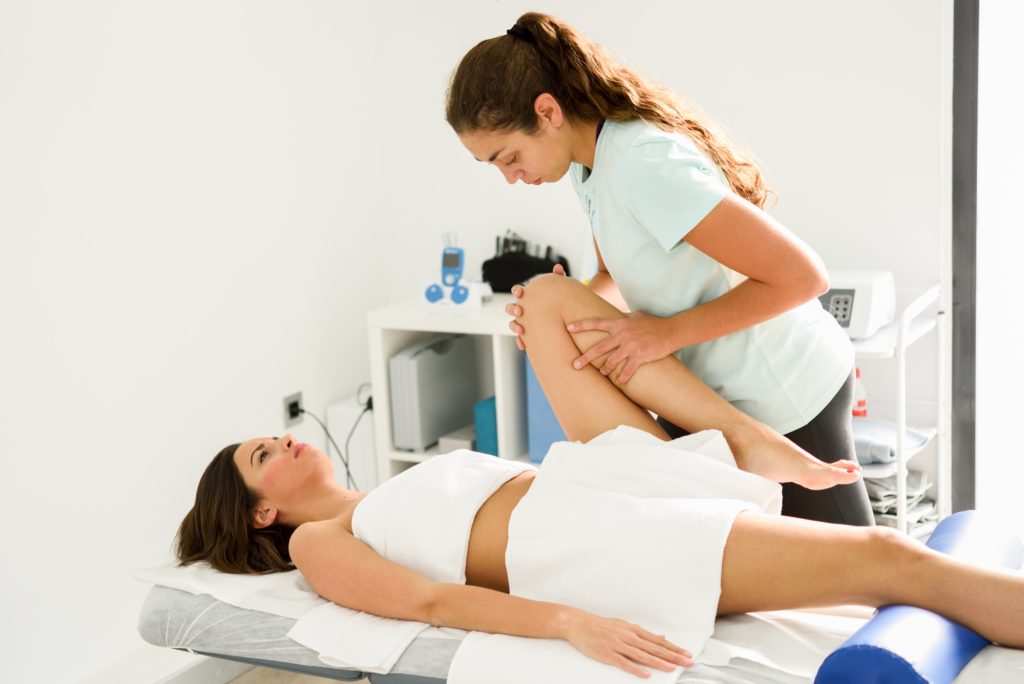Discover the key distinctions between physical therapy for postpartum back pain and regular back pain therapy.
Understanding the Difference Between Physical Therapy for Postpartum Back Pain and Regular Back Pain Therapy

Physical therapy is a fascinating field that can help alleviate pain, improve mobility, and enhance overall well-being. When it comes to back pain, though, there’s an intriguing delineation between postpartum back pain and regular back pain. Let’s dive into the world of physical therapy and explore how it differs in these two contexts.
Defining Physical Therapy: An Overview
First things first, what exactly is physical therapy? Well, it’s a specialized branch of healthcare that focuses on restoring and maintaining physical function and mobility. Physical therapists are like problem-solving wizards, using various techniques and exercises to help people recover from injuries or manage chronic conditions.
But physical therapy is more than just a magical solution to physical ailments. It’s a comprehensive approach to healthcare that considers the whole person and their unique needs. Physical therapists not only treat the symptoms but also address the underlying causes of pain and dysfunction.
Now that we have the basics covered, let’s discover the specific role that physical therapy plays in promoting health and wellness.
The Role of Physical Therapy in Health and Wellness
Physical therapy isn’t just about getting you back on your feet after an injury; it also plays a vital role in preventing injuries, promoting overall fitness, and enhancing your quality of life. Whether you’re an athlete looking to improve performance or someone dealing with a chronic condition, physical therapy can be a game-changer.
By focusing on functional movement and biomechanics, physical therapists help individuals optimize their physical abilities and reduce the risk of future injuries. They work with patients to develop personalized exercise programs that target specific areas of weakness or imbalance, improving overall strength, flexibility, and endurance.
In addition to injury prevention, physical therapy also plays a crucial role in managing chronic conditions. For individuals with conditions such as arthritis, fibromyalgia, or multiple sclerosis, physical therapy can help alleviate pain, improve joint mobility, and enhance overall functional capacity.
Physical therapists are not only experts in physical rehabilitation but also in educating patients about their conditions and empowering them to take an active role in their own healthcare. They provide guidance on proper body mechanics, ergonomics, and lifestyle modifications that can help individuals maintain optimal health and prevent further complications.
Key Techniques Used in Physical Therapy
Physical therapists have an array of tricks up their sleeves to help patients regain strength, improve coordination, and reduce pain. These techniques include manual therapy, therapeutic exercises, electrical stimulation, ultrasound, and more. They carefully assess each patient’s unique needs and tailor their treatment plans accordingly.
Manual therapy involves hands-on techniques such as joint mobilization, soft tissue mobilization, and manual stretching. These techniques aim to improve joint range of motion, reduce muscle tension, and enhance tissue healing.
Therapeutic exercises are an essential component of physical therapy. These exercises are designed to target specific muscle groups, improve strength and flexibility, and restore normal movement patterns. Physical therapists guide patients through these exercises, ensuring proper form and technique to maximize the benefits.
Electrical stimulation is another technique commonly used in physical therapy. It involves the application of electrical currents to stimulate nerves and muscles, promoting pain relief, muscle contraction, and tissue healing. This modality can be particularly beneficial for individuals with muscle weakness or nerve damage.
Ultrasound, on the other hand, utilizes high-frequency sound waves to generate heat deep within the tissues. This can help increase blood flow, reduce inflammation, and promote tissue healing. It is often used for conditions such as tendonitis, bursitis, and muscle strains.
These are just a few examples of the techniques physical therapists use to help their patients achieve optimal physical function and well-being. Each treatment plan is tailored to the individual’s specific needs, ensuring the best possible outcomes.
Unpacking Postpartum Back Pain
Ah, the joys of motherhood. While it’s a beautiful journey, it’s not without its challenges—postpartum back pain being one of them. Let’s explore what causes this pain and how it impacts daily life.
During pregnancy, a woman’s body undergoes numerous changes to accommodate the growing baby. Hormonal changes, such as an increase in relaxin, loosen the ligaments and joints in the pelvis to prepare for childbirth. However, these hormonal changes can also affect the stability of the spine, leading to postpartum back pain.
In addition to hormonal changes, the physical strain of pregnancy can also contribute to back pain. As the baby grows, the mother’s center of gravity shifts forward, causing the spine to curve more than usual. This increased curvature can put stress on the muscles and ligaments in the back, leading to discomfort and pain.
Once the baby is born, the body goes through a period of readjustment. The ligaments and joints that were loosened during pregnancy gradually tighten back up, but this process takes time. As a result, many women experience postpartum back pain as their body adapts to the new normal.
The Causes of Postpartum Back Pain
Postpartum back pain can arise from a combination of factors, including hormonal changes, muscle strain from pregnancy, and the physical demands of caring for a newborn. The spine undergoes significant adaptations during pregnancy, and it takes time for it to readjust after giving birth.
Furthermore, the sleepless nights, awkward feeding positions, and constant bending and lifting associated with caring for a baby can put additional strain on the back, exacerbating the pain. The repetitive motions and poor posture that often accompany these activities can lead to muscle imbalances and further contribute to back pain.
It’s important to note that postpartum back pain is a common issue that many women face. It’s not a reflection of weakness or inability to handle motherhood. Rather, it’s a natural consequence of the physical changes that occur during pregnancy and childbirth.
The Impact of Postpartum Back Pain on Daily Life
It’s amazing how a little one can bring so much joy into your life, but they can also bring some unexpected challenges. Postpartum back pain can make simple tasks like bending, lifting, and carrying your baby feel like Herculean feats. It can affect your mood, energy levels, and ability to fully enjoy this special time with your little bundle of joy.
Imagine trying to change your baby’s diaper while experiencing sharp pain in your lower back. Or attempting to rock your baby to sleep while feeling discomfort radiating down your spine. These everyday activities that should bring joy and bonding can become sources of frustration and physical strain.
Postpartum back pain can also impact your mental and emotional well-being. The constant discomfort and limitations can lead to feelings of frustration, sadness, and even guilt. It’s important to remember that taking care of yourself is crucial for both your well-being and your ability to care for your baby.
Now, let’s delve into how physical therapy can come to the rescue and help postpartum women regain their strength and pain-free mobility.
Physical therapy is a valuable resource for postpartum women experiencing back pain. A skilled physical therapist can assess your specific condition and develop a personalized treatment plan to address your pain and improve your mobility.
Therapeutic exercises can help strengthen the muscles in your back, abdomen, and pelvis, providing support to your spine and relieving pain. These exercises may include gentle stretches, core strengthening exercises, and postural correction techniques.
In addition to exercises, physical therapists may also utilize manual therapy techniques to alleviate pain and promote healing. Techniques such as massage, joint mobilization, and soft tissue manipulation can help reduce muscle tension, improve circulation, and enhance overall well-being.
Furthermore, physical therapists can provide education and guidance on proper body mechanics and ergonomics to prevent future episodes of back pain. They can teach you how to lift and carry your baby in a way that minimizes strain on your back and promotes optimal alignment.
Remember, postpartum back pain is a temporary challenge that can be effectively managed with the right interventions. Seeking help from a physical therapist can make a significant difference in your recovery and overall well-being as you navigate the joys and challenges of motherhood.
Physical Therapy for Postpartum Back Pain
Physical therapy for postpartum back pain is specifically tailored to address the unique needs of new mothers. Let’s discover the wonderful benefits that this specialized treatment can offer.
Tailoring Physical Therapy for Postpartum Women
Physical therapists intimately understand the challenges faced by postpartum women and design individualized treatment plans to address their specific concerns. They focus on core strengthening exercises, pelvic floor rehabilitation, gentle stretching, and proper body mechanics. These interventions not only alleviate pain but also promote overall wellness and support the demands of motherhood.
The Benefits of Physical Therapy for Postpartum Back Pain
The benefits of physical therapy for postpartum back pain are numerous. It can reduce pain, improve muscle strength, enhance posture, and increase overall functional abilities. Physical therapists also provide guidance on ergonomic strategies to prevent future back pain and facilitate a smooth transition into the rigors of motherhood.
Understanding Regular Back Pain
Now that we’ve explored the wonders of physical therapy for postpartum back pain, let’s take a step back and examine what regular back pain entails.

Common Causes of Regular Back Pain
Regular back pain can stem from a variety of factors, including poor posture, muscle imbalances, herniated discs, or even stress. Your sedentary office job or your love affair with the couch binge-watching your favorite series might also be contributing culprits.
Regardless of the cause, living with regular back pain can significantly impact your day-to-day life. Let’s uncover the effects it can have.
The Effects of Regular Back Pain on Quality of Life
Regular back pain can be a real buzzkill, affecting your mood, sleep quality, and ability to engage in activities you love. It’s like an unwelcome houseguest who refuses to leave, robbing you of the joy of living life to the fullest.
But fear not! Physical therapy can help you bid goodbye to back pain and say hello to a pain-free existence, filled with renewed vigor and vitality.
Regular Back Pain Therapy
Physical therapy for regular back pain is a remarkable treatment option that can bring you back to a pain-free lifestyle. Let’s explore some of the approaches used to alleviate regular back pain.
Approaches to Regular Back Pain Therapy
Physical therapists employ a multi-faceted approach to treat regular back pain. They use a combination of hands-on techniques, therapeutic exercises, and modalities such as heat, ice, or electrical stimulation to relieve pain and restore function. These superheroes of the therapy world tailor each treatment plan to suit the unique needs of every individual.
The Effectiveness of Physical Therapy for Regular Back Pain
Physical therapy for regular back pain has been shown to be highly effective. Countless individuals have experienced significant pain reduction, improved mobility, and enhanced quality of life thanks to these therapeutic interventions.
So, if you’ve been battling regular back pain, why not give physical therapy a chance? It’s time to bid farewell to that pesky pain and embrace a life free from backache-induced limitations.
In conclusion, physical therapy is a remarkable field that offers tailored treatments for postpartum back pain and regular back pain. Whether you’re a new mom navigating the challenges of motherhood or someone dealing with everyday back pain, physical therapy can provide the key to unlocking a pain-free and fulfilling life. So, let’s celebrate the wonders of physical therapy and bid farewell to back pain once and for all!



